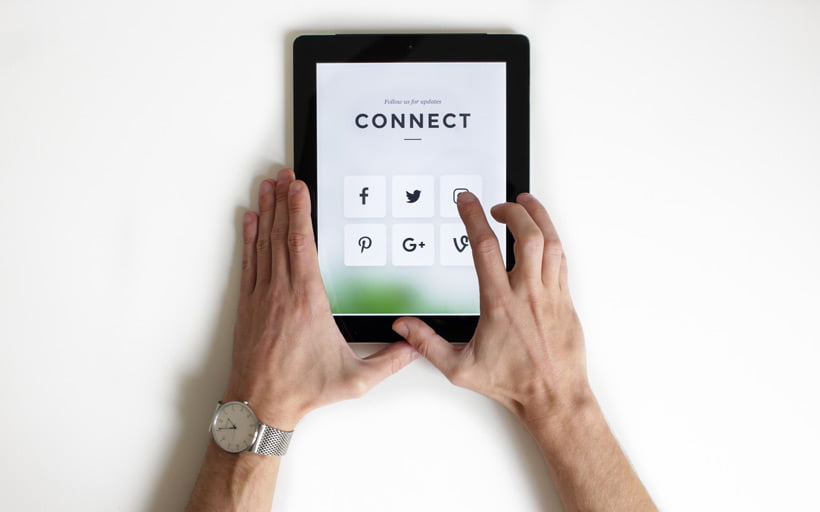Advanced marketing & sales techniques for illustrators & artists
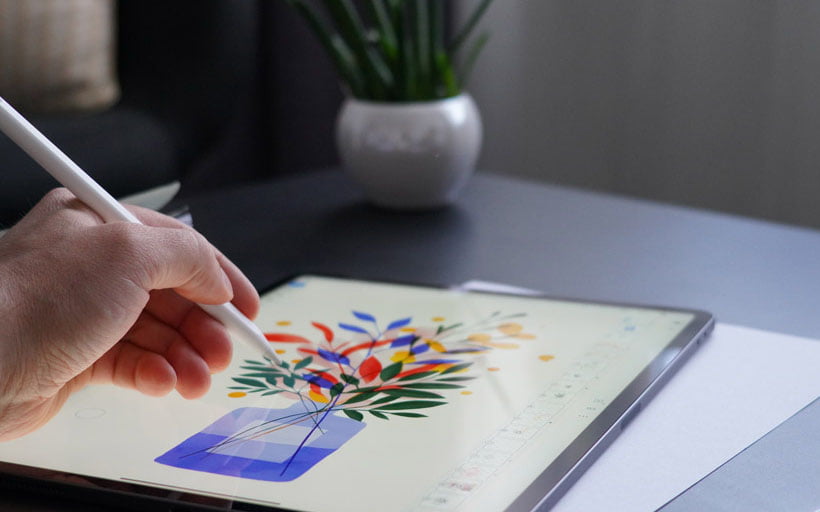
Tags
Interested in joining the world's leading print on demand platform?
In 1995, while researching the painting of the Sistine Chapel, American professor Rob Hatfield made a remarkable discovery.
While studying a series of old documents, he found that Michelangelo — the artist widely believed to have lived the sort of penniless, impoverished life you'd expect from a Renaissance artist — was, in fact, a multimillionaire. While spending much of his life telling anyone who'd listen that he was absolutely broke, he was hiding a staggering fortune which would be worth around $47 million in modern money.
The writer Jeff Goins recounts this story in his book, Real Artists Don't Starve. The 'myth of the starving artist,' is exactly that: a myth. And a harmful one, at that.
Thankfully, the digital age has gone some distance towards breaking down the inexplicable taboo around artists being paid for their work. No more 'art for art's sake'. We increasingly see art that people enjoy, share, and, most importantly, art that helps artists make money.
Print on demand merchandise is a perfect example of a business model that helps illustrators and artists monetise their passion. It's a great way for them to make residual income while concentrating on their main objective: making great art.
It's understandable, then, that many illustrators who sell print on demand merch are only too ready to admit that they'd like to sell more.
Setting up your store and your product range is incredibly quick and easy. But that's really only the beginning. Drumming up more sales and making your new business pay is all about creativity, ingenuity and hustle in your marketing.
In this article, we're going to cover some advanced marketing and sales techniques specifically for illustrators and artists.
Let's leave the 'myth of the starving artist' behind and turn you into a master seller.
Strategy #1: Get more visitors with a lookalike audience
The obvious starting point for growing your sales is to increase your number of customers.
Any brand or influencer with an audience will know that the most fruitful way to grow that audience is to target similar people. For example, in the world of B2B marketing, we often see brands creating buyer personas — fictional representations of their ideal target customer.
It's hardly rocket science, but this simple methodology lets them define the common qualities of their ideal customers so they can target other people who are most likely to be interested in their products or services.
As much as we like to feel that our tastes in art are uniquely our own, it's fair to say that we often share artistic tastes with other, like-minded people from our peer group. So the same principles often apply.
With Facebook Ads, the guesswork is taken out of this process. Facebook's Lookalike Audiences tool is able to programmatically identify the common qualities of the people in a particular segment, which allows you to reach new people who are similar to your existing audience — and are more likely to share the same interests and tastes.
Here's how to set up a Lookalike Audience. First, visit Audiences in Facebook Ads Manager and hit 'Create Audience.'
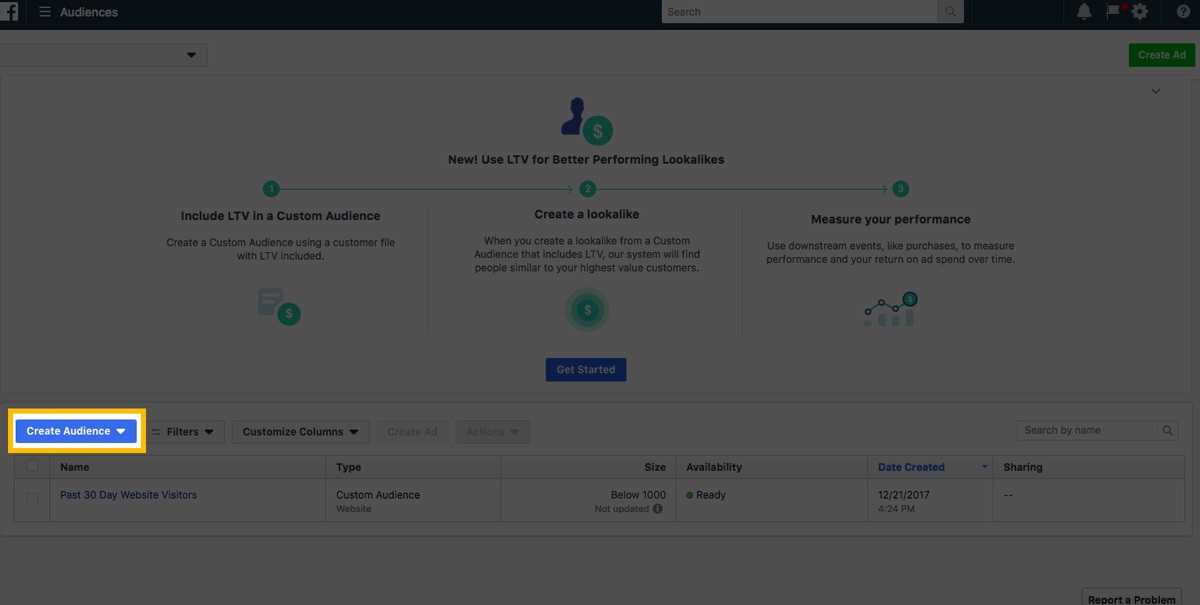
We're going to select 'Lookalike Audience.'
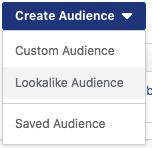
Now, Facebook will ask us from where we want to pull our audience data. We can create Lookalike audiences based on data from a few different sources. They are categorised as 'Value based sources' and 'Other sources.'
'Valued based sources' are based around conversion events tracked by the Facebook Pixel. This sounds a little scary but it's actually a very simple and effective analytics tool that gives you data about the actions people take on your website.
You can set up the Pixel by visiting Facebook Ads Manager > Events Manager > Pixels. If you're using one of the major shopping cart platforms like BigCommerce or Shopify, use the 'Integration or Tag Manager,' to get a complete walkthrough of how to set up the Pixel on your store for yourself. It's a very easy way to get helpful analytics to boost your marketing efforts.
'Other sources' are even more straightforward. These allow you to simply target people who like your Facebook page, for example. If you have a good Facebook following but don't yet have a great deal of traffic to your website, this could be a good starting point.
They also let you target lookalikes of the visitors from custom audiences you've created in the past. For example you can see below that we've set up a 'Past 30 Day Website Visitors' audience for retargeting purposes. If we chose this as our source, Facebook would explore the common qualities of those people who've visited our store in the last month, and then target similar, 'lookalike' users.
Even though you're selling all over the world, you do need to select at least one location for your audience before you can save it. 'Locations' are the countries or economic regions you want to target with your audience.
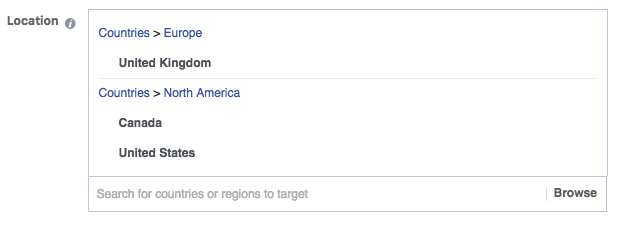
Your final option is to define the balance between audience size and audience targeting. You'll be able to target between 1 and 10% of the total population in the countries you choose — though, of course, the lower percentage, the closer the match to your source.

Once your audience is created and saved, you'll be able to target that audience with your ad campaigns, with messaging specifically designed for acquisition and traffic generation.
Strategy #2: Upsell and cross-sell
Increasing your customer base is probably the most effective way to grow, and it's understandably a big focus for ambitious illustrators and designers.
But, even if you can't grow your customer base, you can still grow your revenue by encouraging your customers to spend more when they buy.
There are two (largely similar) proven techniques for doing this.
- Upselling: offering a more expensive or additional item on the existing order.
- Cross-selling: offering your customers complementary and supporting products they may also be interested in based on their primary purchase.
Our fictional store 'Prodigi Illustrations' have designed the cute piece below and are selling it on a 16”x12” canvas for £35.99.
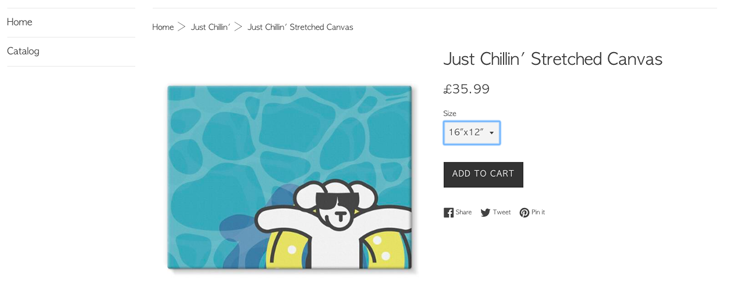
But they also sell this framed version of the same canvas, at the same size, for £59.99.
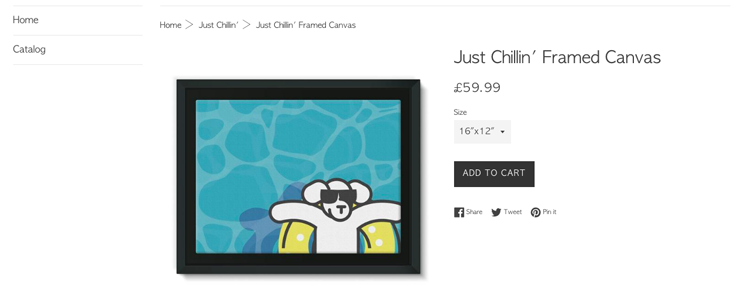
By using an app or plugin for Shopify or BigCommerce (for example SMART Bundle Upsell for Shopify) we can offer our £35.99 customers the opportunity, before they check out, to upgrade their purchase and get a frame for £59.99. That's a fairly natural value-add to the customer who might not have been aware that this product existed. But it's also an increase of around 66% in the order value. It doesn't take many customers to upgrade before this sort of approach makes a significant difference to your overall bottom line.
Another example might be to set up a cross-selling campaign. For example every time somebody buys a beach towel with a Prodigi Illustration on it, they could offer a matching bag to carry it in.
Using SMART, they would set the towel as the 'trigger' product…
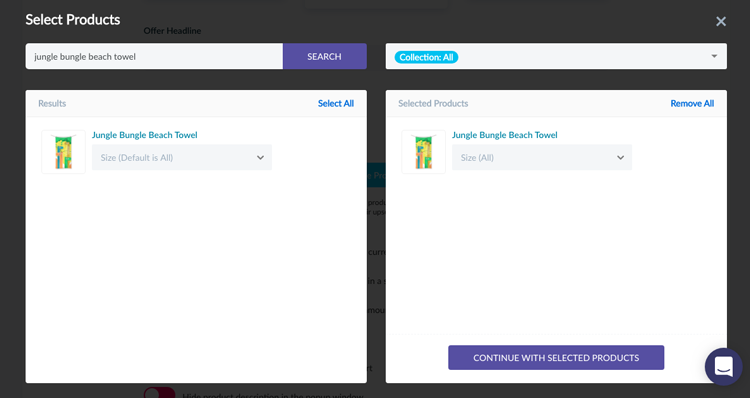
…set the matching bag as their 'bundle' product…
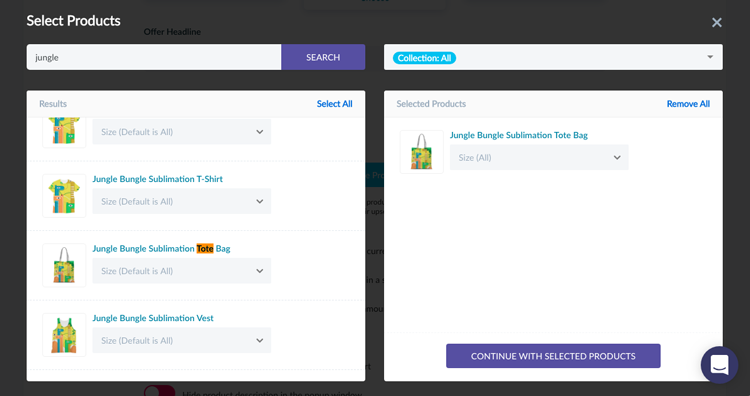
…write some copy to help convince their customers…

…and then be pretty much all set. Before their towel customers reached the checkout, they'd see a message like this one, with only one click required to get the item in their bag.
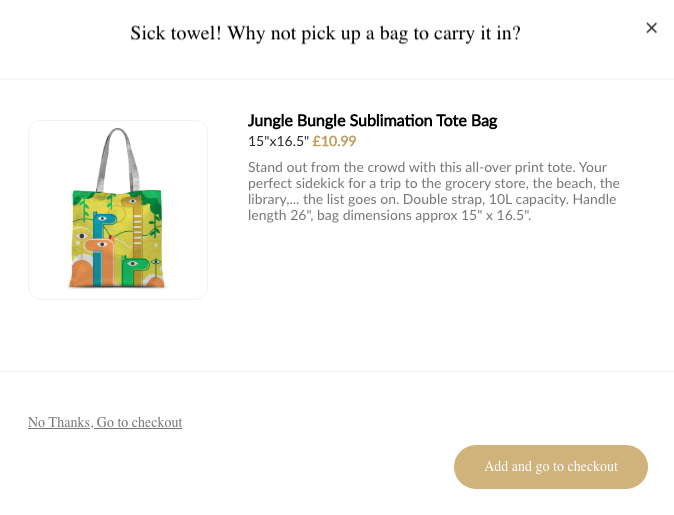
One of the beautiful things about ecommerce is that you can set it and forget it, which means you can set these offers up in your store and then leave them to work their magic. You can be as involved or as distant as you like. Check in to optimise and refine the offers that work best, or just leave them to work in the background. It's up to you!
Strategy #3: Capture and nurture leads with exit email capture
It's an unfortunate reality that many of your visitors won't be ready to buy on their first visit. In fact, while the exact number will differ from one store to the next, SmartInsights research puts the global average conversion rate for Q3 2018 at a measly 2.42%. In simple terms, this means that for every 100 visitors who come to your store — 98 of them, on average, are likely to leave without taking any further action.
Meanwhile, the top converting referral channel in ecommerce is still email.
By building an email list that you control, you can reduce your reliance on third-party social platforms and websites. You can holistically improve your customer communications with email roundups about your art, exhibitions, works in progress — and, of course, your ecommerce offering, boosting awareness and interest in your products.
So how do you grow your email list?
One way you might consider is to employ exit intent popovers on your store. These are designed to identify 'exit intent', i.e. behaviours and patterns that indicate a user is about to leave your store.
When these signals are detected, a popover displays with an offer designed to keep them on-page or hand over their email address for marketing communications.
You can set these campaigns up for free using an app called Privy. Install the app on Shopify or BigCommerce, then hit the 'New Campaign' option highlighted below.
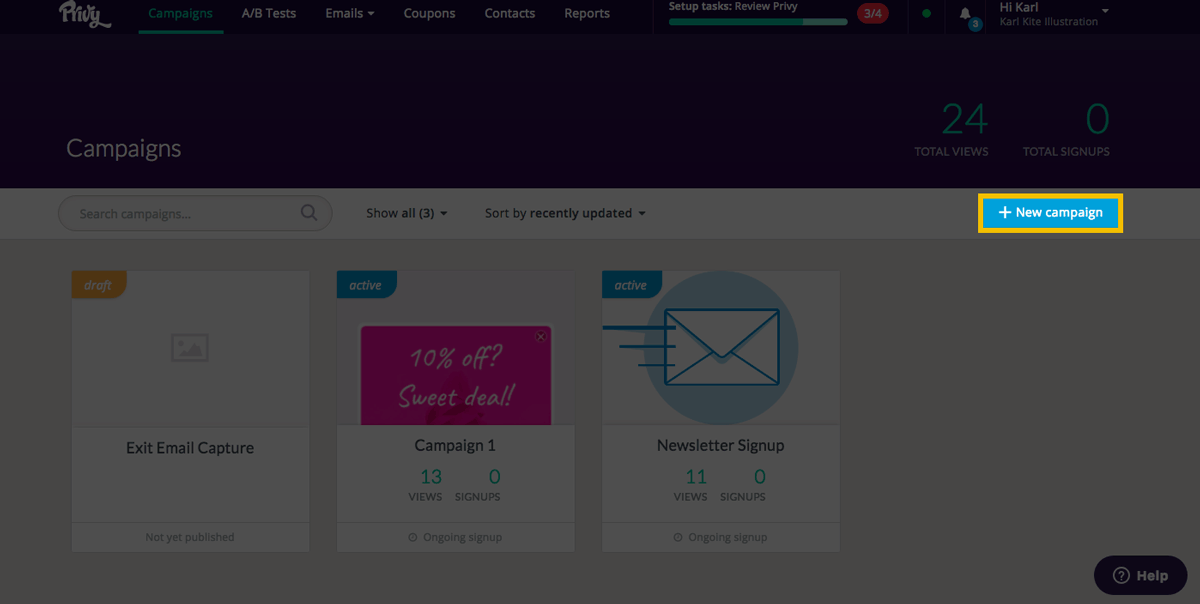
There are a variety of campaigns you can build, and it's well worth spending a little time looking into what these are. But for now, let's just do what we came to do — build an 'Exit Email Capture' campaign.
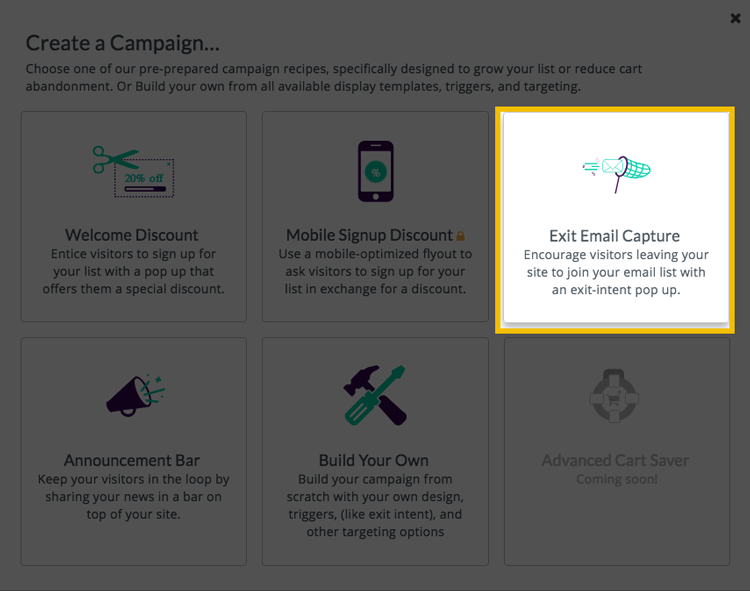
We have some initial sliders to customise our campaign. We can decide whether we use exit intent as a trigger, and limit the number of times per day our users can see these popovers. We'll leave those both 'on' for now and hit 'Design.'
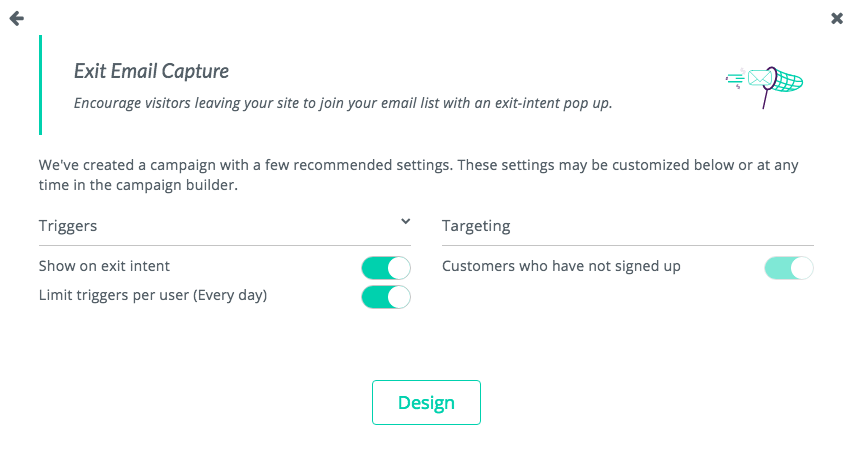
Now we're taken to the Popup Design part of the process. We're given a pretty generic template to work with and we can edit the text and design of what our users will see.
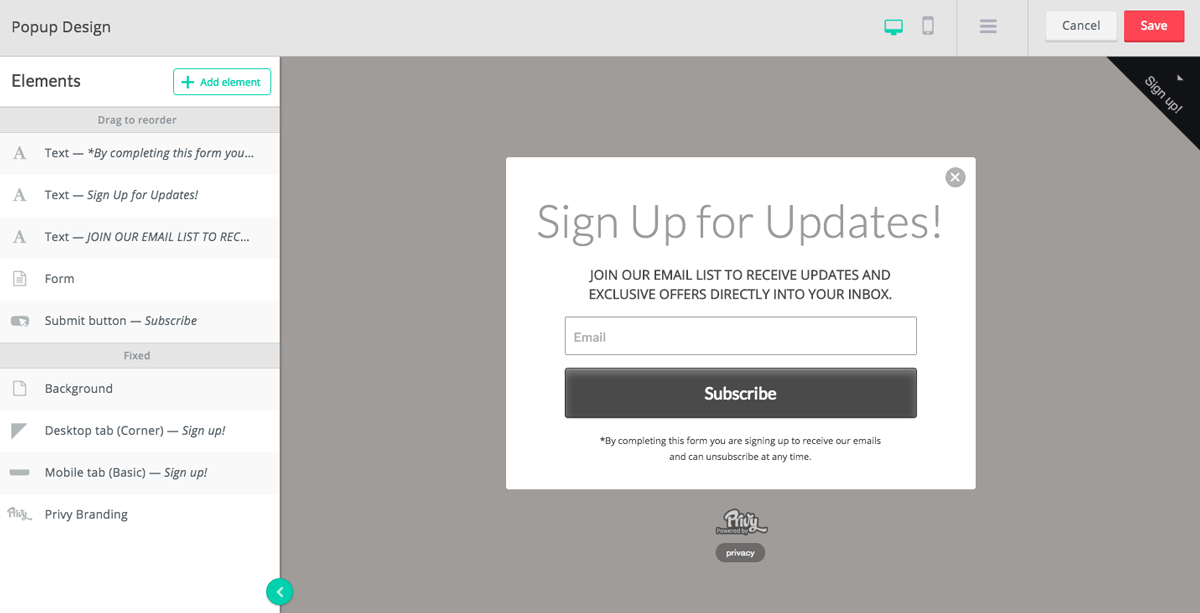
With a few tweaks it's pretty easy to end up with something like this:
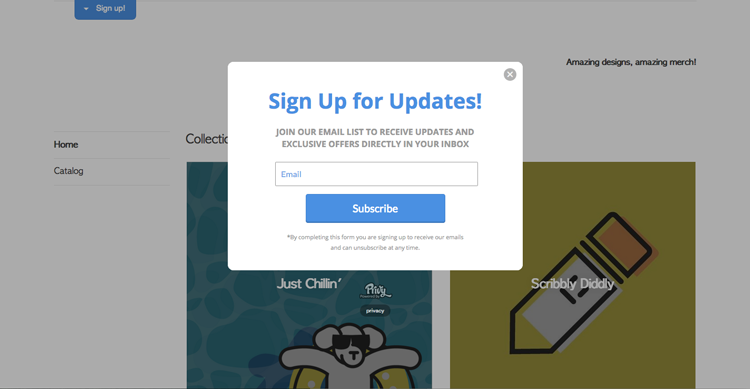
(You can even set up an autoresponder so that everybody who signs up gets a 'Thank you' email to their inbox.)
However, this is only scratching the surface of what's possible. If you click the 'Design' tab, and 'Add a display…' you'll see a huge range of different templates. This doesn't just include the look and feel, but the functionality itself including flyouts, banners, bars and more.
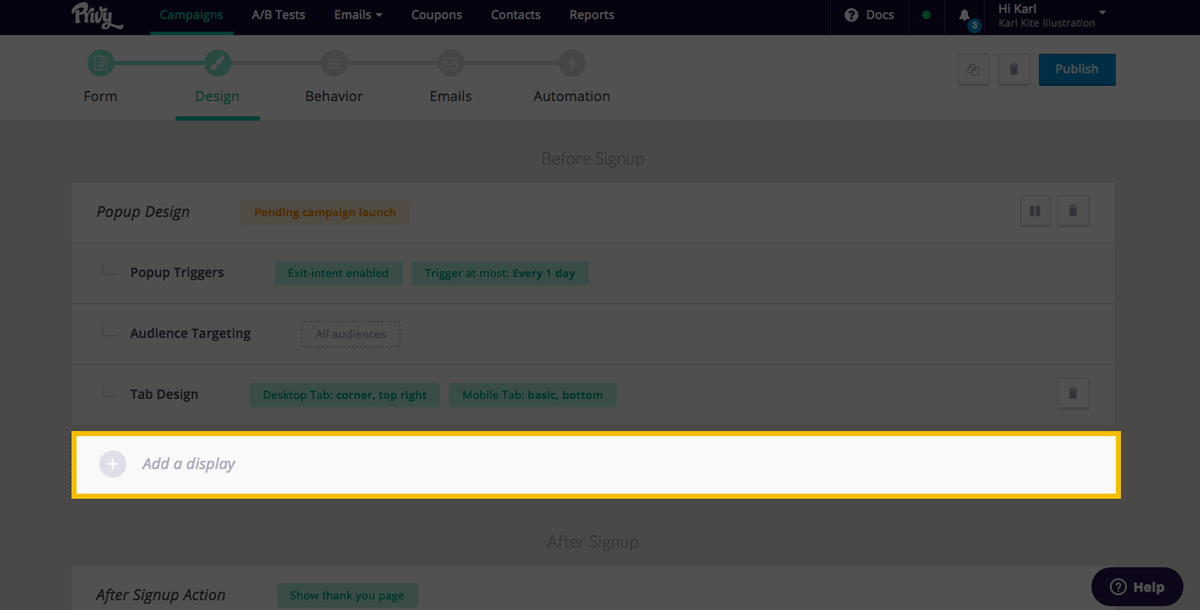

One of the most interesting and original types of popover is the 'Spin to Win' tool offered by Privy. This is particularly enticing for the customer because, rather than simply asking for something, it offers the potential of a reward in return.
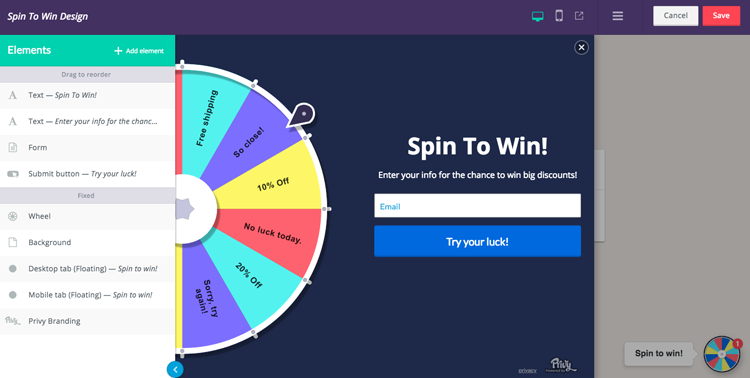
Now, if a customer shows signs of exit intent, they'll see a 'wheel of fortune'.
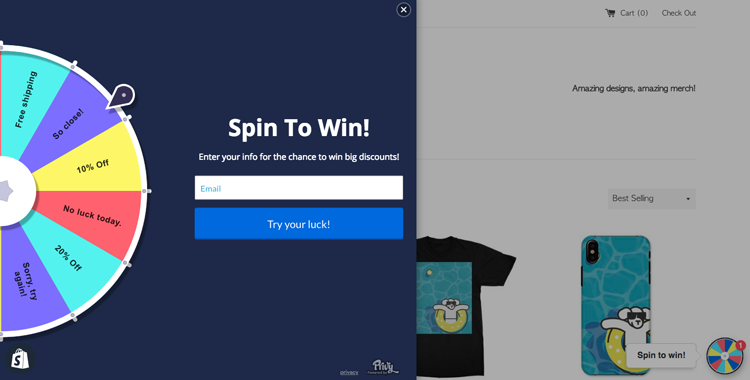
This is doubly valuable for you because a) you're arguably more likely to get an email address, and b) the discount or offer gives the customer a greater incentive to buy on this visit.
Strategy #4: Bring back lost visitors with dynamic retargeting
If email isn't your bag, but you still want to pick up those non-converters, retargeting might be the tactic for you.
This strategy uses the Facebook Pixel we mentioned earlier, so you're going to need to get that installed on your website. To recap: it's pretty easy. Just select 'Pixels' from the Events Manager section in Facebook Ads Manager, then use the 'Integration or Tag Manager,' to go through the exact steps required to integrate the pixel into your store platform.
Once the pixel is installed, it's going to be tracking users who visit your website, letting you use information about their behaviour on your website to target them with highly tailored ads designed to bring them back!
So, if you're looking to set up a basic retargeting campaign (which just targets your recent website visitors with a generic ad) you can do that pretty easily.
First we head to Audiences and create a 'Custom Audience'.
We're going to create this audience based on website traffic and specifically visitors from the past 2 weeks.


We can save this audience in our Ads Manager, and use it in future to reach out to these users in just a few clicks.
We can also go beyond this and set up a 'dynamic' retargeting campaigns. What this means is that the actual ad creative and content a person will see is dependent on the content they were looking at on our website. You're probably familiar with this from when you've been viewing a pair of trainers or a hoodie on a website, and then see an ad featuring that exact product a few days later.
This requires uploading your product catalog to Facebook — which is easy to do through Shopify.
- Login to your Shopify account.
- Next to your Sales channels in Shopify, hit the '+' icon.
- Select 'Facebook' from the menu.
- Click 'Connect' and give Shopify the appropriate permissions to connect with your Facebook page. Facebook will now verify your account information, and you can enable Facebook checkout using your Shopify admin. Your products are now uploaded to Facebook.
- Now, head to Facebook Ads Manager and hit 'Create Ad,' from your Dashboard. You want to select 'Product Catalog Sales' as your objective. Use the 'Custom Audiences' to target your ads to the right people.
And that's it; those people will see the products they've been looking at on your site, giving them timely reminders to head back and buy it!
## Thanks for reading
As an artist or illustrator, print on demand is a fantastic business model that allows you to drive residual income while focusing on the 'bread and butter' of what's important to you: creating great work!
Following some of the strategies we've outlined above can help you reinforce every step of your merchandise sales funnel. From generating more visitors at the 'top' of your funnel, enhancing your on-page conversions by boosting your email list and implementing retargeting campaigns. It can also help increase average order value when people do convert and buy.
Good luck, and happy selling!


